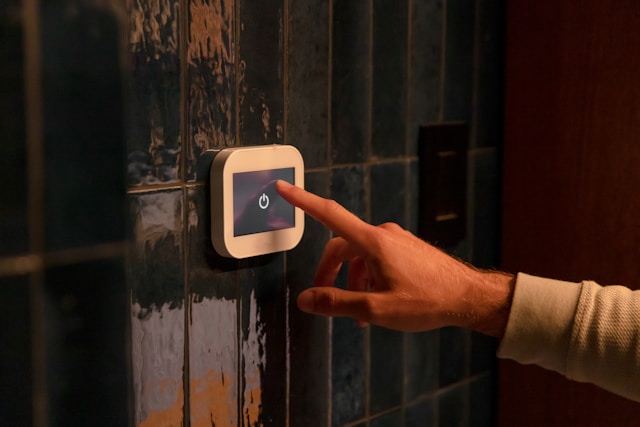Voice automation technologies are transforming how you interact with your home. These systems allow you to control everything from lighting to security using simple voice commands.
With the right setup, you can manage your entire home with just your voice. This convenience is driving more people to explore and invest in smart home technologies.
Tech4U offers advanced solutions to bring this convenience into your space. With expertise in IT and audio-visual setups, we provide tailored services to meet your needs. Whether it’s for a small apartment or a large house, smart home systems make everyday living more efficient and enjoyable.
Overview of Voice Automation Technologies
Voice automation technologies have revolutionized the way we interact with smart homes. This section covers the evolution of voice recognition, compares voice control to traditional interfaces, and examines the key components of voice automation systems, giving you insights into how these technologies work together for a seamless experience.
Evolution of Voice Recognition
Voice recognition has come a long way. Early systems required exact phrasing, but now, thanks to machine learning, voice tech has become highly adaptable and accurate.
- AI advancements allow systems to better understand various accents and languages.
- AI is also improving how systems interpret complex commands, making your interactions smoother.
Voice Control versus Traditional Interfaces
Voice control is all about hands-free convenience. Whether adjusting your thermostat or controlling lighting, you can do it all with simple spoken commands.
- Voice Control: Great for multitasking, especially when your hands are full.
- Traditional Interfaces: Remote controls and touch panels offer more precision and detailed settings adjustments.
Key Components of Voice Automation Systems
The essential components of voice automation systems work together to ensure smooth user interaction.
- Microphones: Capture your voice even in noisy environments.
- Voice Recognition Software: Understands the context of your commands and executes them.
- Smart Device Compatibility: Ensures seamless control of everything from lighting to security systems.
- Security: Secure access and user identification are vital for privacy protection.
Voice-Enabled Devices in Smart Homes
Voice-enabled devices are becoming the backbone of modern smart homes, allowing you to complete tasks hands-free.
Smart Speakers and Hubs
Smart speakers and hubs are the central command centers for most smart homes.
- Smart Speakers: Play music, answer questions, and control devices like lights and thermostats with voice assistants like Alexa or Google Assistant.
- Smart Hubs: Connect and manage multiple devices, creating an integrated smart home system.
Voice-Controlled Home Appliances
From ovens to washing machines, voice-controlled appliances are changing the way we interact with everyday tasks.
- Set timers or ask for recipe instructions while cooking without touching anything.
- Voice commands enhance comfort and efficiency, making multitasking easier.
Wearable Voice-Activated Devices
Wearable devices like smartwatches and fitness trackers have added another level of convenience.
- Use voice commands to send messages, set reminders, and control connected devices even while on the go.
Integration and Interoperability
For voice automation technologies to work seamlessly, they must integrate across various platforms and devices. Ensuring cross-platform compatibility and overcoming challenges is crucial.
Cross-Platform Compatibility
- Most voice assistants (Alexa, Google Assistant, Siri) support multiple protocols, ensuring smooth communication across various devices.
- Look for devices that support multiple ecosystems to ensure compatibility.
Standardization Efforts
Standards like Zigbee, Z-Wave, and Matter help unify devices across brands, making integration smoother.
- When shopping for smart devices, prioritize those that support these standards for easier setup.
Challenges and Solutions
Challenges like latency and connectivity issues can disrupt voice automation systems. To avoid this:
- Keep devices updated with the latest firmware.
- Consider professional installation services to ensure your devices are set up correctly and communicate effectively.
User Experience and Accessibility
Voice automation technology enhances accessibility, especially for users with specific needs.
Personalization and User Profiles
- Tailor your voice commands and settings to match your preferences, such as adjusting lighting or playlists for different times of the day.
- Personalization streamlines routines and makes interactions more intuitive.
Accessibility Features for Elderly and Disabled Users
Voice control is particularly beneficial for elderly and disabled users, offering hands-free control over home devices.
- It simplifies tasks like turning on lights or adjusting thermostats for users with mobility challenges.
Improving User Interface Design
User-friendly voice interfaces enhance the overall experience. Clear, simple commands help avoid misunderstandings, ensuring the system responds accurately.
Security and Privacy Concerns
Voice automation systems offer convenience but require strong security measures to protect sensitive data.
Data Protection and Encryption
- Strong encryption methods are crucial for protecting sensitive data.
- Regular software updates help secure communication between devices and the cloud.
User Authentication Methods
- Multi-factor authentication (MFA) adds extra security, combining something you know (password), something you have (smartphone), and something you are (biometrics).
- Biometric authentication, like voice recognition, is increasingly used in smart homes for both convenience and security.
Regulations and Compliance
Voice automation systems must comply with privacy regulations like GDPR and CCPA.
- Ensure your system adheres to these standards to protect consumer data and maintain trust.
Advancements in Natural Language Processing (NLP)
- NLP improvements allow systems to understand context and nuances, enhancing their ability to respond to complex commands.
- Future systems aim to make communication with devices as natural as possible.
The Role of Artificial Intelligence
AI allows systems to learn from your habits, personalizing your smart home environment.
- AI also plays a role in security by recognizing unusual activity patterns and adjusting home settings accordingly.
Predictions for Smart Home Ecosystems
The smart home ecosystem will continue to grow, with systems becoming more interconnected.
- Voice automation might control entire systems, from lighting to heating, with a single command.
- Increased use of biometric authentication could make homes even safer.
Implementation Strategies
Effective planning and ongoing support are key to a successful voice automation system.
Planning and Deployment
- Start with simple tasks, such as controlling lights and thermostats.
- Develop a budget and ensure compatibility across devices for smooth integration.
Training and Support for Users
- Training ensures that all household members can use the new technology effectively.
- Regular support and resources like video tutorials can help address issues as they arise.
Evaluating Success and ROI
- Regularly assess your system’s effectiveness by tracking metrics like ease of use, energy savings, and time efficiency improvements.
- Evaluate ROI by comparing initial costs with long-term benefits, such as energy savings and increased convenience.
Voice-Activated Appliances
Smart appliances, such as ovens and refrigerators, respond to voice commands, making tasks like cooking or grocery list management easier.
Best Practices and Recommendations
- Use Clear Voice Commands: Speak naturally and distinctly for accurate responses.
- Customize Your Settings: Personalize settings for your convenience, such as creating shortcuts for frequently used commands.
- Educate Household Members: Make sure everyone knows how to use the system effectively.
- Set Up Routines: Create commands to control multiple devices at once.
- Regular Updates: Keep software updated to ensure functionality and security.
- Ensure Security: Protect your system with strong passwords and additional authentication methods.
- Limit Network Congestion: Only connect necessary devices to your network to avoid lag.
The Future of Smart Homes is Voice-Activated
Voice automation is transforming the way we interact with our homes, making everyday tasks simpler, more efficient, and even more enjoyable.
If you need assistance with your voice-activated setup, we can help integrate and maintain your voice-automation system for a seamless smart home experience.

